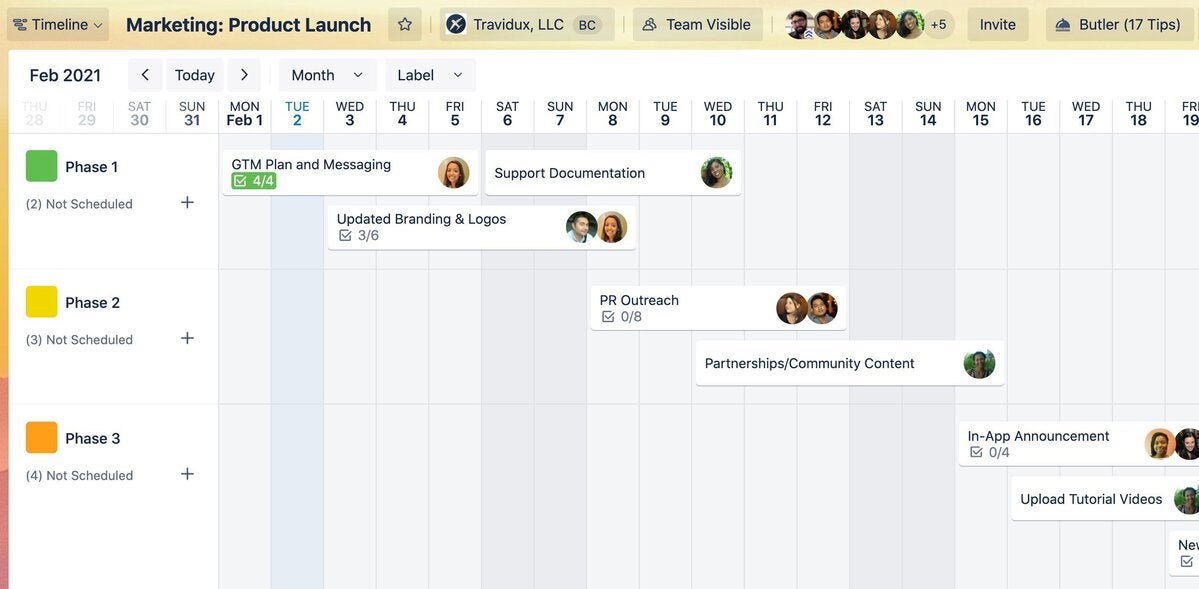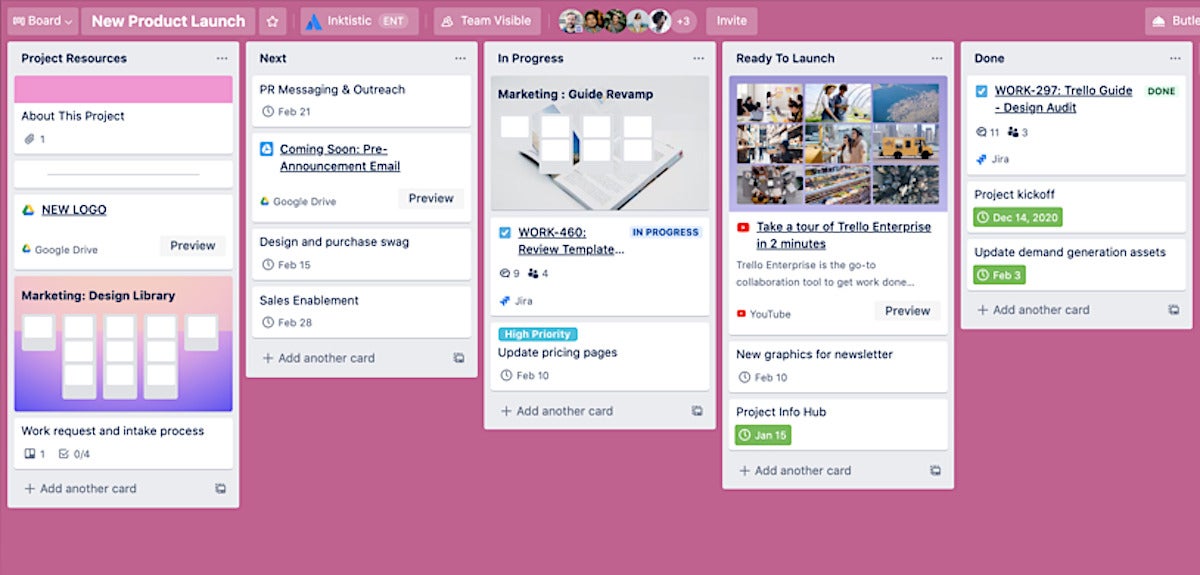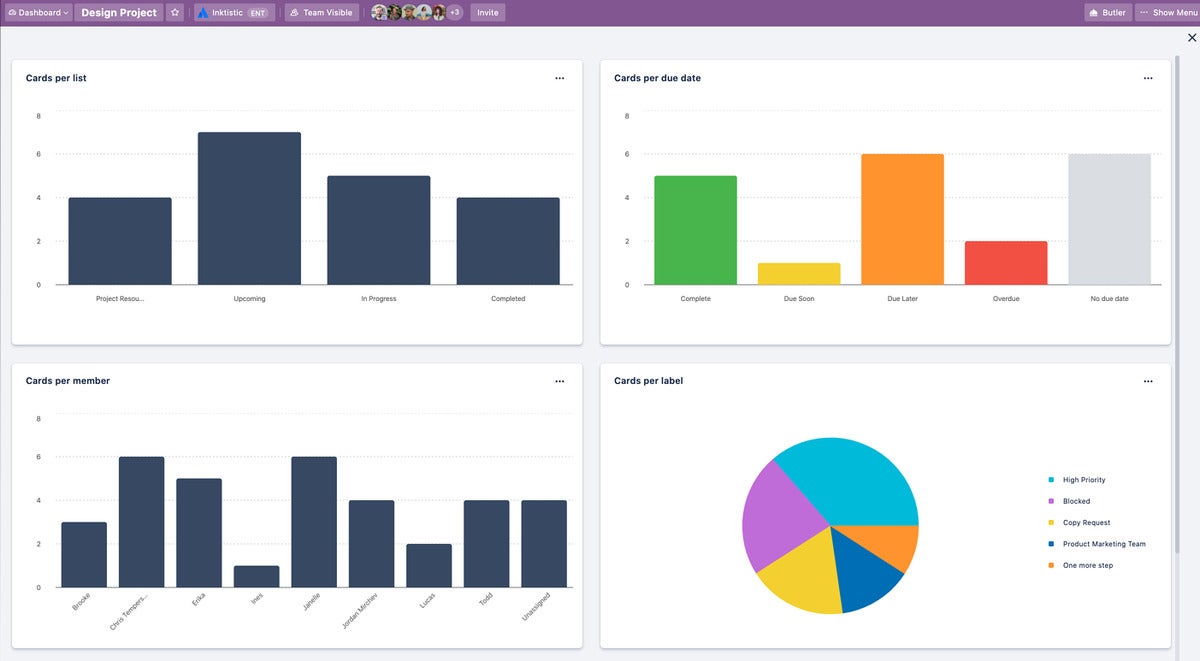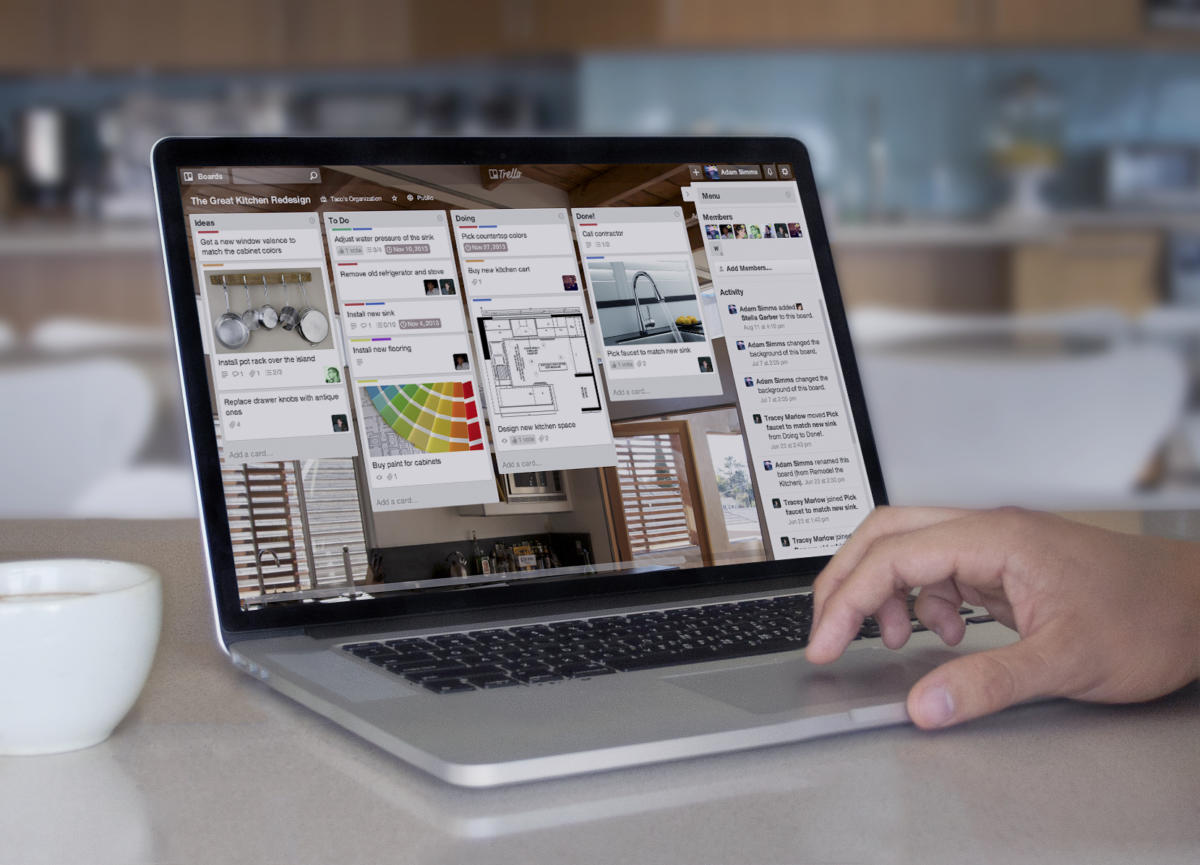Trello is a collaborative work management app designed to track team projects, highlight tasks underway, show who they are assigned to, and detail progress towards completion.
At its core, Trello relies on the principles of Kanban project boards to visualize workflows, providing managers and team members with a simple overview of a project from start to finish.
Trello’s key components are boards, lists, and cards.
Boards are the starting point, and typically focus on an over-arching project such as launching a new website, or process-based tasks, such as on-boarding an employee. Within each board, several lists can be created to indicate the progress of a project; “to do,” “in progress,” and “done” lists are common examples. Individual cards within the lists hold information on a specific task and can be moved from list to list as needed (such as when a task is completed).
 Trello
Trello
Trello's timeline view.
Each card can contain a broad range of task information, including a text description, file attachments, automations, comments, and more.
Users navigate Trello from a “home view” that acts as a hub and central newsfeed. This allows them to easily jump to boards or surface all of the cards a user might have missed since last logging in.
Trello — which was acquired by software vendor Atlassian in 2017 — integrates well with other applications, too, using what the company calls “power-ups.” These API integrations allow users to access features in Slack, Salesforce, Gmail, or other apps (as well with Atlassian’s own products) directly from Trello.
A big part of Trello’s appeal is its ease of use and versatility: the app is often also used for personal itineraries, including anything from planning holidays to weddings. In that sense, it differs from full-featured project management software, prioritizing lightweight functionality and accessibility over a broad feature set.
“Unlike project management applications like Microsoft Project that target traditional project managers, Trello can be used across the organization by anyone that needs to manage projects but does not need or want a specialized – and complex – project management tool,” said Raúl Castañón, senior analyst at 451 Research, a division of S&P Global Market Intelligence.
Atlassian sought to make Trello even more powerful with the introduction of workflow automations after it acquired Butler and integrated its features into the app. This lets users set up simple rules to automate repetitive tasks such as moving a cards to the “done” list when a checklist is complete, for instance.
 Trello
Trello
Trello cards provide project information in easy-to-digest ways to simplify task management.
Trello pricing
Trello, which revamped its pricing structure on Aug. 24, now offers four tiers: Free, Standard, Premium, and Enterprise.
The free tier requires users to sign up, and provides access to unlimited power-up integrations, unlimited storage (up to 10MB per file), 250 Butler automations, and other features. But the number of accessible boards is limited to 10.
The recently introduced Standard tier adds advanced checklists and custom fields, additional Butler automations, and higher file size storage (up to 250MB per file. It costs $5 per user each month, when paid annually.
The Premium option – $10 per month – has unlimited Butler automations, added dashboard, timeline and calendar views, and admin and security tools.
The top-tier Enterprise plan includes further security measures designed for deployments at large businesses. These measures include organization-wide permissions, mobile device management integration, and other admin-focused capabilities. The Enterprise version offers a range of pricing plans, depending on the number of users. It starts at $17.50 per user a month.
How Trello compares to alternatives
Demand for work management tools was on the rise even before the Covid-19 pandemic. The growing popularity of remote work and hybrid workplaces has only increased the need for tools to coordinate tasks among disparate teams.
In fact, Gartner expects spending on social and collaboration platforms to rise 17% this year to $4.5 billion, with spending on work management platforms being the biggest driver.
It’s a competitive field. Alongside Trello, a variety of work management software vendors have emerged to capitalize on business demand. Among these are Asana and Monday, both which completed IPOs in the past 12 months, at valuations of $4 billion and $7.5 billion, respectively. In recent months, other competitors in the space have been acquired, including Workfront (bought by Adobe for $1.5 billion) and Wrike (bought by Citrix for $2.25 billion).
Microsoft also has a task management tool, Planner, which is part of its Microsoft 365 suite.
Many of these tools are built around the same Kanban-style to-do list approach popularized by Trello; they offer similar boards, lists, and card layouts, as well as other “views.” Most also include automations and collaborative features.
Other rivals take a more spreadsheet-centric view of project management; these include well-funded standalone apps such as Smartsheet and Airtable, as well as products such as Microsoft Lists and Google Tables.
Trello has long held a significant market share, thanks mainly to its ease of use. There were at least 50 million registered users in 2018, according to the most recent stats publicly available, though Atlassian said the figure is now significantly higher. It has also benefited from integration into Atlassian’s portfolio of apps such, as Jira.
“It combines ease of use and flexibility with powerful capabilities, making it an effective tool across a wide range of use cases,” said Castañón.
Furthermore, momentum gained during the COVID-19 lockdown shows that Trello is a “natural fit” for supporting team collaboration in a distributed workforce, he said.
“All in all, Trello stands out against other similar tools; however, it is facing growing competition from adjacent categories. This will be perhaps its main challenge moving forward,” he said.
How Trello plans to evolve
Trello earlier this year announced an overhaul of its app, to coincide with the 10-year anniversary of its launch.
Among other changes, Trello has gotten several new board views: table, timeline, dashboard, and calendar. These provide different perspectives allowing users to view and interact with the information held in boards.
 Trello
Trello
Trello's Dashboard view visualizes key metrics such as due dates, assigned cards, and cards per list.
Going forward, Trello said users will be able to move cards across different boards in each of the different views, just as is possible with the table view currently. Third-party developers will also be able to create their own apps and services to connect with the various board views in future.
Trello now offers three new card types: link cards, board cards, and mirror cards. Link cards, for instance, can connect with apps such as Dropbox or Google Drive by pasting a URL in the card’s title, and can display a preview of the content.
“Trello has been ahead of the curve in several ways,” said Castañón.
That said, the app now faces stronger competition than it’s seen in the past, particularly as some elements of work management apps become embedded in existing productivity tools. For example, Fluid Components are part of Microsoft 365, and Smart Canvas is incorporated into Google Workspace. Those integrations make lightweight task management features available in a range of document types.
“Updates by Microsoft and Google also reflect that Trello faces an intensely competitive space, with the roadmap for productivity tools increasingly incorporating work management capabilities,” Castañón said.









